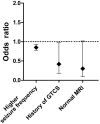Factors associated with failed focal neocortical epilepsy surgery
- PMID: 25181435
- PMCID: PMC4393951
- DOI: 10.1227/NEU.0000000000000530
Factors associated with failed focal neocortical epilepsy surgery
Abstract
Background: Seizure outcomes after focal neocortical epilepsy (FNE) surgery are less favorable than after temporal lobectomy, and the reasons for surgical failure are incompletely understood. Few groups have performed an in-depth examination of seizure recurrences to identify possible reasons for failure.
Objective: To elucidate factors contributing to FNE surgery failures.
Methods: We reviewed resections for drug-resistant FNE performed at our institution between 1998 and 2011. We performed a quantitative analysis of seizure outcome predictors and a detailed qualitative review of failed surgical cases.
Results: Of 138 resections in 125 FNE patients, 91 (66%) resulted in freedom from disabling seizures (Engel I outcome). Mean ± SEM patient age was 20.0 ± 1.2 years; mean follow-up was 3.8 years (range, 1-17 years); and 57% of patients were male. Less favorable (Engel II-IV) seizure outcome was predicted by higher preoperative seizure frequency (odds ratio = 0.85; 95% confidence interval, 0.78-0.93), a history of generalized tonic-clonic seizures (odds ratio = 0.42; 95% confidence interval, 0.18-0.97), and normal magnetic resonance imaging (odds ratio = 0.30; 95% confidence interval, 0.09-1.02). Among 36 surgical failures examined, 26 (72%) were related to extent of resection, with residual epileptic focus at the resection margins, whereas 10 (28%) involved location of resection, with an additional epileptogenic zone distant from the resection. Of 16 patients who received reoperation after seizure recurrence, 10 (63%) achieved seizure freedom.
Conclusion: Insufficient extent of resection is the most common reason for recurrent seizures after FNE surgery, although some patients harbor a remote epileptic focus. Many patients with incomplete seizure control are candidates for reoperation.
Figures


References
-
- Wiebe S, Blume WT, Girvin JP, Eliasziw M. A randomized, controlled trial of surgery for temporal-lobe epilepsy. N Engl J Med. 2001;345(5):311–318. - PubMed
-
- Spencer S, Huh L. Outcomes of epilepsy surgery in adults and children. Lancet Neurol. 2008;7(6):525–537. - PubMed
-
- Englot DJ, Breshears JD, Sun PP, Chang EF, Auguste KI. Seizure outcomes after resective surgery for extra-temporal lobe epilepsy in pediatric patients. J Neurosurg Pediatr. 2013;12(2):126–133. - PubMed
MeSH terms
Grants and funding
LinkOut - more resources
Full Text Sources
Other Literature Sources

